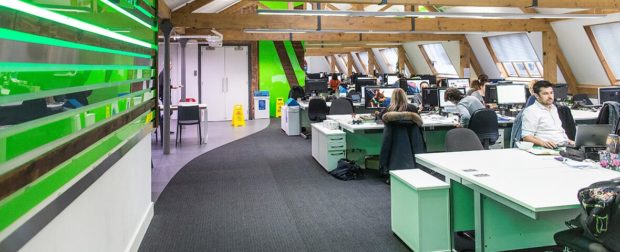Open Space Offices – Boon or Bane?
Open space offices are vibrant, without secrecy, but beneficial, because operators create a better rapport and work in a team. The initial idea of different commercial office fit outs was sketched back in 1950 by a unit in Hamburg, who deemed that this would ease dialogue between employees.
Now, approximately 70% of all working sectors adopted this bias, so we assume that it serves. But some of the results indicate differently. We interpret the obstacles and benefits – whether open space functions and why some employees still hide behind partitions.


Advantages of open space office
The theory that cuts down the walls in today’s workspaces: Open space office should enhance workflow and communication. Sounds fair? Maybe not.
One article notes that the modern agencies accepted this concept and as advantages, the state better communication, collaboration and speed of work and for this reason, they suggest tear down barriers and walls. They also point out that leaders of agencies see positive benefits and increased productivity as a result of this. It also depends on the location where you want to locate your office. Choosing the right space will be beneficial for your employees too, For these reasons, you can rent an office space in Atlanta, which is one of the country’s best places to start a new business and motivate your team, because it has quickly become an attractive place for entrepreneurs with its low cost of living, convenient transportation, and available tech hubs.
But what happens to the privacy and confidential telephone conversations and so on?
Disadvantages of this concept
- There is no productivity and satisfaction for employees, because of the lack of privacy.
- There is no space which is really just for them.
- Different ways of working are not shown and Fare not recognized.
- Creativity is forced, because all eyes are on you and whether this is a good solution?
Employees have complained that they feel too exposed, combined with too much noise, they are not enough concentrated. Because everyone has their own rhythm. People come to work at different times, take a break at different times, want to socialize at different times and are most productive in different periods of the day. The job of management is to adjust all of this and create a space where all these conflicts reconcile.
Everyone seems to have rushed to tear down all the walls in workplaces, but now they want to return some of them. Modern offices are trying to achieve the golden middle through design, without returning all walls. For that reason, there is a new concept that has been created in order to find the golden middle. For that reason, a new concept has been created.
For example, one Microsoft team decided to have closed and private offices, and when employees need to cooperate, they just meet in the hallway where they have conversations. When they finish, everybody retreats back to their solitude.
On the other hand, instead of the employees meet in the hallways, there are new office concepts that combine comfortable space where employees can sit together and collaborate. This concept is balanced with private telephone rooms and closed spaces for meetings. Indeed, it seems that some walls are essential to modern offices.
Why will the concept of open space offices survive?
Those who are currently working in open space offices have learned that it is not always easy, safe and pleasant to work in open space and that everyone looks for a workspace, where they will be able to think, where they do not listen to a colleague across the way that phone calls and the like.
Also, it is sometimes necessary for people to meet and work together, so they could come up with solutions and perform a task easier and better, and this certainly requires a common area. Cooperation is sometimes necessary for the business, because of the more people, the more skills and ways of thinking.